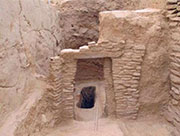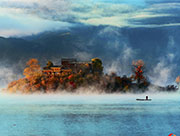

Red wetland and crabs make the city a pearl in Northeast China.
If you are looking for a holiday to treat both your eyes and taste buds, Panjin, a coastal city in Northeast China's Liaoning province, is a little-known treasure.
It is relatively unknown compared with its southern counterparts such as Hangzhou in Zhejiang province and Xiamen in Fujian province.
But, as word of mouth spreads, Panjin is becoming a hot tourist destination in Northeast China, especially in October when a vast expanse of water reeds paints the city's wetland a rosy red, and hairy crabs, grown in the rice paddies are ready to harvest.
Every year, from September to October, the immense coverage of water grass, adaptable to the saline and alkaline soil in Panjin Honghaitan Wetland Tourist & Holiday Resort at the delta of Liaohe River changes color, from luscious green to flaming red to deep purple.
The stunning weed-blanketed mud flats, covering an area of 6,667 hectares, is growing closer to Bohai Bay at the rate of 50 meters every year. The park also boasts the world's largest reed marsh that produces 500,000 tons of raw materials for papermaking a year.
A wooden bridge allows visitors to meander into the heart of the thick red carpet of red weed. Boats are also available for a slow sail across this temporary sea of red.
Besides the vast expanse of red wetland, the park is also the temporary home for numerous migratory birds, including a number of rare species such as the red-crowned crane.
Flocks of birds arrive and leave the preserve in search of warmer climates from spring to autumn.
A museum and a zoo have been built recently allowing visitors to learn more about the wildlife and ecosystem of the wetland. The park administration also offers activities to enrich the stay of tourists, such as horse riding and a kart-racing track for children.
About 50 kilometers to the north at the Hujia township of Panshan county there is the highly-sought delicacy of the season-hairy crabs.
Lyrics in a folk song widely sung in Panjin in the 1960s said crabs even climbed into people's beds, which may sound exaggerated but reflects the fact crab were so abundant in the area. Farmers processed the crabmeat into a special tofu or paste. Nowadays, crab farming has bought prosperity for more and more local households.
Unlike the best-known hairy crabs in China, which are raised in Suzhou's Yangcheng Lake, crabs in Panjin are raised in the rice paddies.
Although shadowed by the popularity of crabs from Yangcheng Lake, crabs from Panjin have their own advantages, such as early maturing and a unique taste. The height of the crab harvest in Panjin usually comes 45 days earlier than those of Yangcheng Lake.
Because the number of freshwater ponds that can be used for crab cultivation is limited, a local aquaculture expert developed a technique to raise crabs in rice paddies in the 1990s.
The new technique creates an eco-win-win situation by combining planting with breeding. Waste and the carbon dioxide crabs expel provide invaluable nutrients for rice seedlings. Meanwhile, plants and pests in the rice fields provide the crabs with a constant supply of food and shade.
The crab-rice farming model has been promoted in Panjin and has enhanced local farmers' income from higher output compared with the traditional farming in freshwater ponds.
Sun Xiuling is a pioneer in farming crabs. Sun, who started from scratch, now leads a cooperative that consists of more than 100 households to raise crabs. Her cooperative sells about 500,000 kg of crabs nationwide every year.
"Our hairy crabs taste so good that some customers can eat as many as 20 crabs in one sitting," she said. One female crab sells for at least 10 yuan while males cost 15 yuan.
The most traditional way of cooking crab is steaming. Diners can taste the sweet and tender meat of crab by dipping it in vinegar and minced ginger.
The crustaceans can be packed in boxes with ice bags to maintain their freshness if buyers plan to purchase some to take away.
If eating crabs is not enough, you might enjoy trying to catch one from a rice field. A look at how crabs swim and hide in the paddies is itself an eye-opener.
If you go
Road and rail connect Panjin with Beijing and major cities in Liaoning province. The red wetland in Panjin is 550 km from Beijing and 155 km from Shenyang, the capital of Liaoning province. It takes about seven hours by ordinary train from the Beijing Railway Station to Panjin city, and only four hours by high-speed rail. There is no public transport from Panjin city to the wetland but tourists without their own vehicles can sign up for a tour at local hotels. The fee is usually 150 yuan per person, including the return trip and entrance ticket.
 |
Day|Week

 "Luxury" art apples debut in Shanghai
"Luxury" art apples debut in Shanghai Photos and hand-painted pictures brighten the military training life
Photos and hand-painted pictures brighten the military training life Models steal the light at Nanjing auto expo
Models steal the light at Nanjing auto expo Magnificent Xian H-6 strategic bomber
Magnificent Xian H-6 strategic bomber Bikini models compete in oriental beauty pageant
Bikini models compete in oriental beauty pageant Archaeologists find 4,000-year-old sentry post in Shaanxi
Archaeologists find 4,000-year-old sentry post in Shaanxi Stunning photos of air show in China’s V-Day parade
Stunning photos of air show in China’s V-Day parade Chinese couple claim title for Guinness world's tallest married couple
Chinese couple claim title for Guinness world's tallest married couple Left-behind child faces separation from father after summer vacation
Left-behind child faces separation from father after summer vacation Scenic Liangshan: Photographers' paradise
Scenic Liangshan: Photographers' paradise